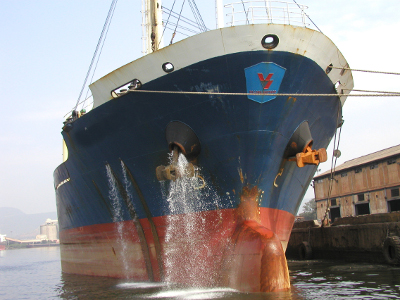ODU's Dobbs and Colleague Report Failure of Ballast Water Treatment Tests
January 14, 2015
 Fred Dobbs
Fred Dobbs
 A ship emptying ballast water
A ship emptying ballast water
An international testing program intended to prevent the spread of diseases by ships' ballast water is a failure, according to a study that was released online today by the peer-reviewed journal Marine Pollution Bulletin.
First author of the article is Andrew Cohen, director of the Center for Research on Aquatic Bioinvasions in Richmond, Calif. His collaborator in the study and coauthor is Fred Dobbs, an oceanographer at Old Dominion University in Norfolk, Va., who has been researching the microbial ecology of ships' ballast water for two decades.
Tests of bacteria removal from ships' ballast water were designed so treatment systems are guaranteed to pass, whether or not they work, according to the scientists. Overall, they found that 95 percent of the tests administered between 2004, when the program started, and 2013 were invalid. (See http://bioinvasions.org/mediaresources.)
Dozens of treatment systems have been approved for use in the United States and international waters based on these tests.
Ballast water, which is carried on ships to maintain proper buoyancy, typically contains millions of tiny organisms, including human pathogens. These pathogens can be introduced into new regions of the world in ballast discharges. Shipboard treatment equipment designed to remove these organisms is tested and certified under a program created by the United Nation's International Maritime Organization (IMO) in 2004, which includes tests for the removal or killing of target microbes that are indicators of bacteria that cause human disease.
However, the new study reports that for the past 10 years most of these tests have been run with test water that contained few to no target microbes, so that it was impossible for the treatment equipment to fail.
According to Cohen of the Center for Research on Aquatic Bioinvasions, "The equipment being tested would have passed the microbe tests even if it hadn't been turned on."
Cohen and Dobbs report that in nearly two-thirds of these tests administered between 2004 and 2013 there were no detectable target microbes in the test water before treatment.
Because these tests were defective, they provided no information on the ability of the treatment systems to prevent the transport and release of bacteria that cause human disease. In fact, in some cases the treatment used may make things worse. By removing small organisms that eat bacteria, some treatment systems turned ballast tanks into bacteria incubators, so that the treated discharges consistently contained higher concentrations of bacteria-in some trials, thousands of times higher-than discharges that were left untreated. It is not known whether the increased bacteria included human pathogens.
There is evidence, however, that ballast water has spread human pathogens. In the 1990s ballast water introduced a strain of pandemic cholera into U.S. waters and contaminated fish and oysters, and probably introduced the strain into South America, where it killed over 10,000 people. Outbreaks of cholera and some other bacterial diseases are associated with increased coastal water temperatures because the bacteria thrive in warmer waters. Climate change will likely increase the impact of whatever diseases are spread in ballast water.
"Since treatment is our main defense against spreading diseases in ballast water," Cohen said, "failing to test the treatment equipment may have serious consequences."
Analyses of the bacteria found in ballast water have raised additional concerns.
"Dozens of species of pathogenic bacteria have been identified in ballast water," noted Dobbs, of Old Dominion University. "Our previous work showed that antibiotic-resistant bacteria are also found in ballast water. Since resistance genes can be transferred from one bacterium to another, putting pathogenic bacteria and resistant bacteria together in a ballast tank risks the creation of new and dangerous strains. If ballast treatment isn't effective, these strains could be released into the environment."
The study by Cohen and Dobbs addressed two sets of test protocols, both of which they found to be equally flawed with regard to microbiological targets. (The study does not address the performance of ballast water systems in the treatment of organisms larger than microbes.)
More stringent test protocols are needed and currently approved treatment systems will need to be re-tested, the scientists say.
Treatment equipment is estimated to cost an average of around $1 million per ship, and up to $8-12 million for some large ships. Globally, the shipping industry is expected to spend around $70 billion on ballast water treatment equipment over 10 years.
The article, "Failure of the Public Health Testing Program for Ballast Water Treatment Systems," will be published soon in the peer-reviewed journal Marine Pollution Bulletin. The article was released online Jan. 14.
Contact:
Dr. Andrew Cohen acohen@bioinvasions.com (510) 778-9201
Dr. Fred Dobbs fdobbs@odu.edu (757) 683-5329

